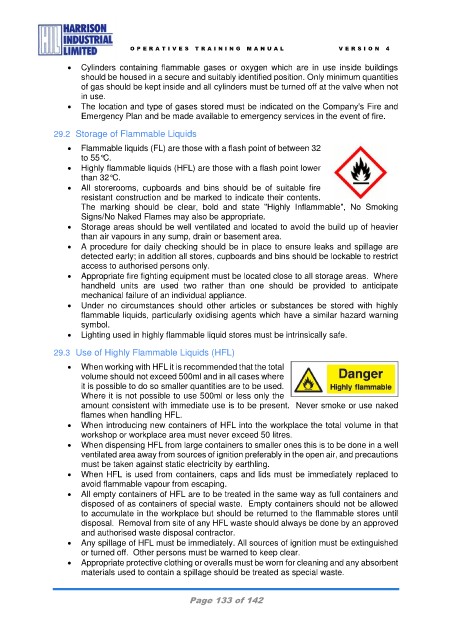Page 134 - HIL Operatives Training Manual V4 16022024_Neat
P. 134
O P E R A T I V E S T R A I N I N G M A N U A L V E R S I O N 4
• Cylinders containing flammable gases or oxygen which are in use inside buildings
should be housed in a secure and suitably identified position. Only minimum quantities
of gas should be kept inside and all cylinders must be turned off at the valve when not
in use.
• The location and type of gases stored must be indicated on the Company's Fire and
Emergency Plan and be made available to emergency services in the event of fire.
29.2 Storage of Flammable Liquids
• Flammable liquids (FL) are those with a flash point of between 32
to 55°C.
• Highly flammable liquids (HFL) are those with a flash point lower
than 32°C.
• All storerooms, cupboards and bins should be of suitable fire
resistant construction and be marked to indicate their contents.
The marking should be clear, bold and state "Highly Inflammable", No Smoking
Signs/No Naked Flames may also be appropriate.
• Storage areas should be well ventilated and located to avoid the build up of heavier
than air vapours in any sump, drain or basement area.
• A procedure for daily checking should be in place to ensure leaks and spillage are
detected early; in addition all stores, cupboards and bins should be lockable to restrict
access to authorised persons only.
• Appropriate fire fighting equipment must be located close to all storage areas. Where
handheld units are used two rather than one should be provided to anticipate
mechanical failure of an individual appliance.
• Under no circumstances should other articles or substances be stored with highly
flammable liquids, particularly oxidising agents which have a similar hazard warning
symbol.
• Lighting used in highly flammable liquid stores must be intrinsically safe.
29.3 Use of Highly Flammable Liquids (HFL)
• When working with HFL it is recommended that the total
volume should not exceed 500ml and in all cases where
it is possible to do so smaller quantities are to be used.
Where it is not possible to use 500ml or less only the
amount consistent with immediate use is to be present. Never smoke or use naked
flames when handling HFL.
• When introducing new containers of HFL into the workplace the total volume in that
workshop or workplace area must never exceed 50 litres.
• When dispensing HFL from large containers to smaller ones this is to be done in a well
ventilated area away from sources of ignition preferably in the open air, and precautions
must be taken against static electricity by earthling.
• When HFL is used from containers, caps and lids must be immediately replaced to
avoid flammable vapour from escaping.
• All empty containers of HFL are to be treated in the same way as full containers and
disposed of as containers of special waste. Empty containers should not be allowed
to accumulate in the workplace but should be returned to the flammable stores until
disposal. Removal from site of any HFL waste should always be done by an approved
and authorised waste disposal contractor.
• Any spillage of HFL must be immediately. All sources of ignition must be extinguished
or turned off. Other persons must be warned to keep clear.
• Appropriate protective clothing or overalls must be worn for cleaning and any absorbent
materials used to contain a spillage should be treated as special waste.
Page 133 of 142

